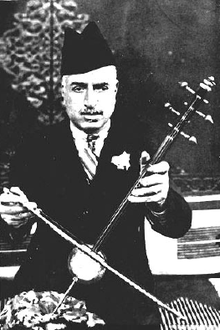Rebab


The rebab (Arabic: ربابة, variously spelled rebap, rabab, rebeb, rababa and rabeba, also known as جوزه jawza or joza in Iraq[1]) is a type of a bowed string instrument so named no later than the 8th century and spread via Islamic trading routes over much of North Africa, the Middle East, parts of Europe, and the Far East.[2] The bowed variety often has a spike at the bottom to rest on the ground (see first image to the right), and is thus called a spike fiddle in certain areas, but plucked versions like the kabuli rebab (sometimes referred to as the robab or rubab) also exist.
Besides the spike fiddle variant, there also exists a variant with a pear-shaped body, quite similar to the Byzantine lyra and the Cretan lyra. This latter variant travelled to western Europe in the 11th century,[3] and became the rebec.
This article will only concentrate on the spike-fiddle rebab, which usually consists of a small, usually rounded body, the front of which is covered in a membrane such as parchment or sheepskin and has a long neck attached. There is a long thin neck with a pegbox at the end and there are one, two or three strings. There is no fingerboard. The instrument is held upright, either resting on the lap or on the floor. The bow is usually more curved than that of the violin.
The rebab, though valued for its voice-like tone, has a very limited range (little over an octave), and was gradually replaced throughout much of the Arab world by the violin and kemenche. The Iraqi version of the instrument (jawza or joza) has four strings.
Construction
The rebab is used in a wide variety of musical ensembles and genres, corresponding with its wide distribution, and is built and played somewhat differently in different areas. Following the principle of construction in Iran, the rebab is a large instrument with a range similar to the viola da gamba, whereas versions of the instrument further west tend to be smaller and higher-pitched. The body varies from being ornately carved, as in Java, to simpler models such as the 2-string Egyptian "fiddle of the Nile." They may have a body made of half a coconut shell, while the more sophisticated versions have a metal soundbox, and the front may be half-covered with beaten copper, and half with cowskin.
Persia, Arabia, Iraq and the Ottomans

The rebab was heavily used, and continues to be used, in Arabic Bedouin music as well traditional Iraqi music under the name "joza", named after the sound box material made of a coconut shell . There is also a bowed instrument in Persian music named Kamanche which has similar shape and structure. The Rebab is also played in Afghanistan and Pakistan, however they are unrelated in terms of origin.
For a famous Iranian singer and rebab player see Hassaan Egzaar Chenani.
Asian heartland

The spike fiddle variants are very commonly used by many North, East and Central Asian ethnic groups and their diaspora around the world, such as the Huqin variety used by most ethnic groups of China, the khoochir and morin khuur of Mongolia, the Byzaanchy of Tuva, the Haegeum of Korea, kyl kiak of Kyrgyzstan, Saw sam sai of Thailand and many others. These are generally used in playing traditional folk tunes, but have also become popular in arrangements of contemporary music, including such genres as classical, jazz, and rock.[5]
Southeast Asia

In the Indonesian gamelan the rebab is an essential elaborating instrument, ornamenting the basic melody. A two-string bowed lute consisting of a wooden body, traditionally though now rarely a single coconut shell, covered with very fine stretched skin.[6] Two brass strings are tuned a fifth apart and the horse hair bow is tied loosely (unlike modern Western stringed instruments) with the proper tension controlled by the players bow hand, contributing to the difficult technique.[6] There are typically two per ensemble, one for pelog and one for slendro, never played together.[6]
The rebab does not have to conform exactly to the scale of the other gamelan instruments and can be played in relatively free time, finishing its phrases after the beat of the gong ageng (the big gong that "rules" the ensemble, see: colotomy). The rebab also frequently plays the buka when it is part of the ensemble.[7]
In the eastern Malaysian states of Kelantan and Terengganu, the Rebab is used in a healing ritual called "Main Puteri". The musician healer is sometimes taken to hospitals in cases where doctors are unable to heal ailing patients.
See also
- Byzantine lyra, the medieval bowed instrument of the Byzantine Empire
- Gadulka
- Gudok
- Gusle
- Huqin, large family of traditional Chinese spike fiddles
- Kamancheh
- Kemenche
- Kobyz
- Lijerica
- Lyra of Crete
- Rebec
- Rubab (instrument)
References
Citations
- ↑ Archived December 1, 2008, at the Wayback Machine.
- ↑
- ↑ "rabab (musical instrument) - Encyclopedia Britannica". Britannica.com. Retrieved 2013-08-17.
- ↑ Archived June 11, 2010, at the Wayback Machine.
- ↑ "Erhu - Chinese violin / fiddle with two strings - and Erhu music (audio & video demo)". Philmultic.com. Retrieved 2013-08-17.
- 1 2 3 Lindsay, Jennifer (1992). Javanese Gamelan, p.30-31. ISBN 0-19-588582-1.
- ↑ Neil Sorrell. A Guide to the Gamelan. London: Faber and Faber, 1990. Pp. 97-98.
Sources
- Margaret J. Kartomi: On Concepts and Classifications of Musical Instruments. Chicago Studies in Ethnomusicology, University of Chicago Press, 1990
External links
| Wikimedia Commons has media related to Rebab. |
| Wikisource has the text of the 1911 Encyclopædia Britannica article Rebab. |
- Turkish Rebab Master Ibrahim Metin Ugur
- Nay-Nava the encyclopedia of persian music instruments
- Rebab
- The Rebab
- Arabic rababa photo
- nuke.liuteriaetnica.it
- FERNWOOD, an American music group that uses a Rebab.
- Matthaios Tsahouridis


